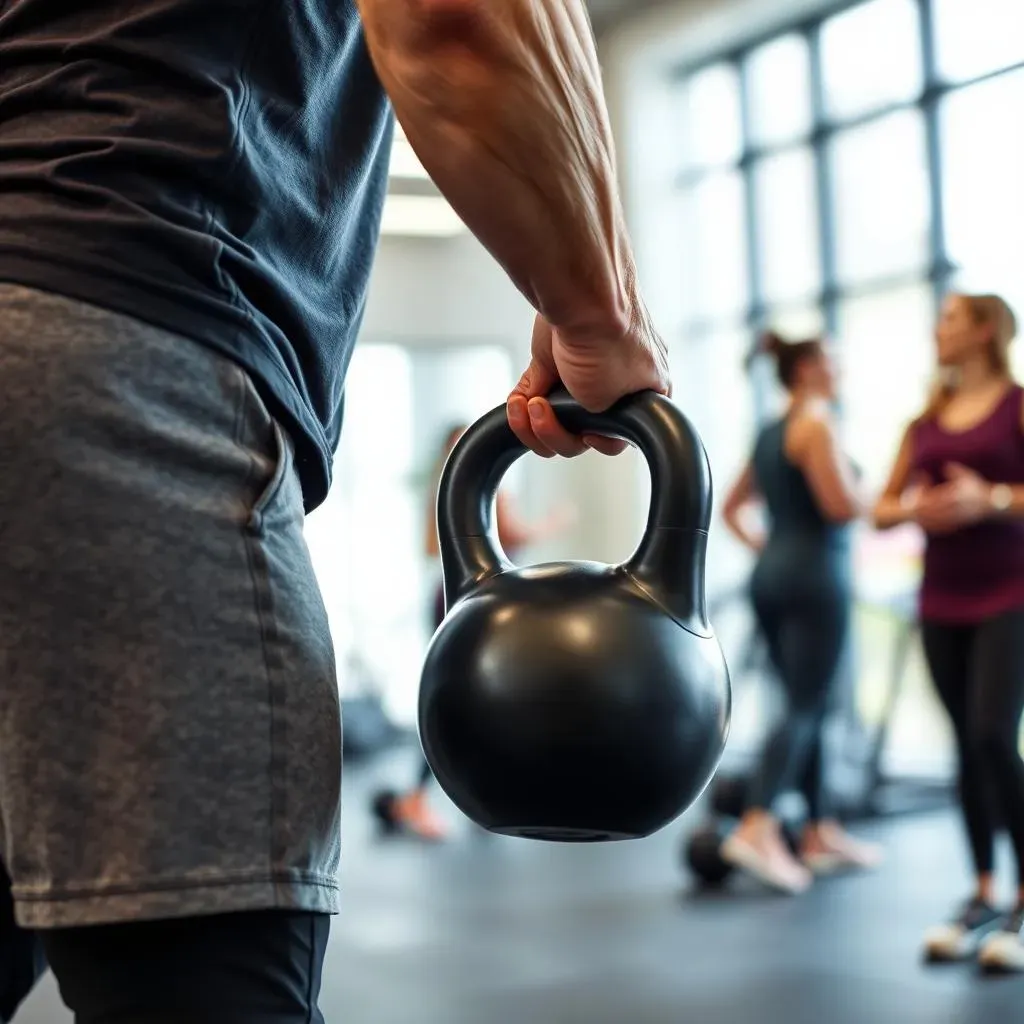Table of Contents
Bored with your regular workout? Looking to seriously crank up the intensity? Then it's time to grab a pair and dive into the world of 2 kettlebell workouts. This isn't just about holding two weights; it's about doubling the challenge, the coordination, and ultimately, the results. But before you jump in headfirst, understand this: mastering the single kettlebell is non-negotiable. Think of it as earning your stripes before entering the big leagues. Can you confidently swing, clean, and squat with one kettlebell? Great! Then you're ready to explore the dynamic and demanding realm of double kettlebell training.
Mastering the Basics: Single Kettlebell Foundations for 2 Kettlebell Workouts

Mastering the Basics: Single Kettlebell Foundations for 2 Kettlebell Workouts
Alright, so you're itching to jump into 2 kettlebell workouts? Awesome! But before you even think about picking up that second bell, let's have a real talk about the single kettlebell. Seriously, this isn't just some "beginner" phase you can skip. It's the bedrock upon which all your double kettlebell success (and safety) will be built. Think of it like learning to dribble before trying to dunk – you wouldn't see LeBron James skipping the fundamentals, would you? Mastering single kettlebell exercises ensures you have the necessary strength, coordination, and movement patterns ingrained in your nervous system. Without this foundation, you're just asking for trouble – whether it's poor form, injury, or simply not being able to handle the increased load and complexity.
Why is this so crucial? Because when you double the weight, you double the demands on your body. Every muscle, every joint, every stabilizer has to work in perfect harmony. If you're compensating for weaknesses or imbalances with a single kettlebell, those issues will be amplified when you add a second. You'll be trying to balance twice the weight, control twice the momentum, and coordinate twice the movement. It's a recipe for disaster if you're not properly prepared. So, let's make sure you've got the single kettlebell basics down cold before moving on. Trust me, your body will thank you.
So, what exactly does "mastering the basics" mean? It's not just about being able to perform the exercises; it's about performing them with impeccable form, control, and efficiency. It's about owning the movement, not just going through the motions. Can you perform a single kettlebell swing without rounding your back or yanking with your arms? Can you clean the kettlebell smoothly and efficiently, without banging it against your wrist? Can you squat deep and maintain proper alignment, even when fatigued? These are the questions you need to ask yourself. If the answer to any of them is "no," then you need to spend more time honing your single kettlebell skills.
Single Kettlebell Exercise | Why It's Essential for Double Kettlebells |
|---|---|
Kettlebell Swing | Develops hip hinge power, essential for double swings and cleans. |
Kettlebell Clean | Teaches proper racking position, crucial for double cleans and presses. |
Goblet Squat | Builds lower body strength and stability, necessary for double squats. |
Turkish Get-Up | Enhances core stability and shoulder mobility, important for all double kettlebell exercises. |
Double the Bells, Double the Burn: A Sample 2 Kettlebell Workout Complex

Double the Bells, Double the Burn: A Sample 2 Kettlebell Workout Complex
so you've put in the time with the single kettlebell and you're ready to take on the challenge of a 2 kettlebell workout complex. Awesome! Now, let's talk about putting it all together. A complex is simply a series of exercises performed back-to-back without putting the kettlebells down. This ramps up the intensity, builds serious endurance, and forces you to maintain focus and control throughout. It's not just about strength; it's about mental toughness, too. This sample complex is designed to be challenging but scalable, so adjust the weight and reps as needed to match your current fitness level. Remember, form is paramount. Don't sacrifice technique for the sake of completing the complex.
Before you dive in, make sure you've warmed up properly. A few minutes of dynamic stretching and light cardio will get your blood flowing and prepare your muscles for the work ahead. Also, have a clear understanding of each exercise in the complex. Review the proper form and technique to minimize the risk of injury. And most importantly, listen to your body. If you feel any sharp or persistent pain, stop immediately. There's no shame in scaling back or taking a break. The goal is to challenge yourself, not to destroy yourself. Now, let's get into the complex!
- Double Kettlebell Clean: 5 reps
- Double Kettlebell Front Squat: 5 reps
- Double Kettlebell Press: 5 reps
- Double Kettlebell Row: 5 reps
- Double Kettlebell Deadlift: 5 reps
Rest for 2-3 minutes after completing one round of the complex. Aim for 2-3 rounds total. As you get stronger, you can increase the weight, reps, or rounds to continue challenging yourself. Remember, consistency is key. Stick with it, and you'll see results.
Top 5 Double Kettlebell Exercises to Supercharge Your 2 Kettlebell Workouts

Top 5 Double Kettlebell Exercises to Supercharge Your 2 Kettlebell Workouts
Alright, now for the good stuff! You've built your foundation, you've tackled a complex, now it's time to unleash the power of specific double kettlebell exercises. These aren't just random movements; they're carefully selected to maximize strength, power, and overall athleticism. Each exercise offers unique benefits, targeting different muscle groups and challenging your body in new ways. So, without further ado, here are my top 5 double kettlebell exercises to supercharge your 2 kettlebell workouts:
- Double Kettlebell Clean and Press: This is the king (or queen) of double kettlebell exercises. It's a full-body movement that builds explosive power, strength, and coordination. It targets your legs, core, shoulders, and arms, making it a true powerhouse exercise.
- Double Kettlebell Front Squat: Forget what you know about squats. Holding two kettlebells in the front rack position dramatically increases the challenge, forcing you to engage your core and maintain impeccable posture. This exercise builds serious lower body strength and stability.
- Double Kettlebell Swing: Yes, you can do swings with two kettlebells! This variation takes the classic kettlebell swing to a whole new level, demanding even more power and coordination. It's a fantastic way to build explosive hip drive and improve cardiovascular fitness.
- Double Kettlebell Renegade Row: This exercise combines the stability challenge of a plank with the strength-building benefits of a row. It targets your back, shoulders, core, and arms, making it a fantastic exercise for overall upper body strength and stability.
- Double Kettlebell Deadlift: Double kettlebell deadlifts are great for building raw strength and power in your posterior chain. It's an amazing way to work your hamstrings, glutes, and back.
But remember, don't just jump into these exercises without proper preparation. Start with lighter weights and focus on mastering the technique. Gradually increase the weight as you get stronger and more comfortable. And always listen to your body. If you feel any pain, stop and reassess. Safety first, always!
Exercise | Benefits | Tips |
|---|---|---|
Double Clean and Press | Full-body strength, power | Focus on explosive hip drive |
Double Front Squat | Lower body strength, core stability | Maintain upright posture |
Double Swing | Hip power, cardio | Keep back straight, hinge at hips |
Double Renegade Row | Upper body strength, core stability | Maintain plank position |
Double Deadlift | Posterior chain strength | Keep back straight, engage lats |
Progressing Safely: Integrating 2 Kettlebell Workouts into Your Routine

Progressing Safely: Integrating 2 Kettlebell Workouts into Your Routine
Start Slow and Steady
so you're pumped about integrating 2 kettlebell workouts into your routine, right? That's awesome! But let's not get ahead of ourselves. This isn't a race; it's a journey. And like any journey, it's best to start with a solid plan. The biggest mistake people make is trying to do too much, too soon. They jump right into advanced exercises with heavy weights, and then wonder why they end up injured or burned out. Don't be that person! Instead, start slow and steady. Begin by incorporating just one or two double kettlebell exercises into your existing workouts. Focus on mastering the technique and building a solid foundation of strength and stability. Gradually increase the weight, reps, or sets as you get stronger and more comfortable.
Think of it like learning a new language. You wouldn't try to write a novel on day one, would you? You'd start with the alphabet, then move on to simple words and phrases. It's the same with kettlebells. Start with the basics, and gradually build your way up to more complex movements. This approach will not only minimize your risk of injury but also maximize your long-term progress. Remember, consistency is key. It's better to do a little bit consistently than to do a lot sporadically. So, be patient, be persistent, and trust the process. You'll get there!
Listen to Your Body
This might sound cliché, but it's absolutely crucial. Your body is your best guide. It will tell you when you're pushing too hard, when you need to rest, and when you're ready to progress. The problem is, most people don't listen. They ignore the warning signs, push through the pain, and end up paying the price. Don't make that mistake! Pay attention to your body. If you feel any sharp or persistent pain, stop immediately. Don't try to tough it out. Pain is a signal that something is wrong, and it's important to address it before it becomes a bigger problem.
Also, be mindful of your overall fatigue levels. 2 kettlebell workouts are incredibly demanding, both physically and mentally. If you're constantly feeling tired or drained, it's a sign that you're overtraining. Take a break, reduce your training volume, and prioritize recovery. Get enough sleep, eat a healthy diet, and manage your stress levels. These things are just as important as the workouts themselves. Remember, it's not just about how hard you train; it's also about how well you recover. So, listen to your body, prioritize recovery, and you'll be able to train harder, longer, and more effectively.
Warning Sign | Possible Cause | Action |
|---|---|---|
Sharp Pain | Injury | Stop immediately, seek medical attention |
Persistent Soreness | Overtraining | Reduce training volume, prioritize recovery |
Fatigue | Overtraining, poor recovery | Get more sleep, eat healthy, manage stress |
Double the Bells, Double the Results: Your Journey with 2 Kettlebell Workouts
So, you've explored the power of 2 kettlebell workouts, learned about foundational exercises, and even tackled a sample complex. Remember, this isn't a race; it's a journey. Prioritize proper form, listen to your body, and gradually increase the weight and intensity as you progress. Double kettlebell training is a potent tool for building strength, power, and endurance, but only when approached with respect and intelligence. Now go forth, grab those bells, and unleash your inner beast – responsibly, of course!